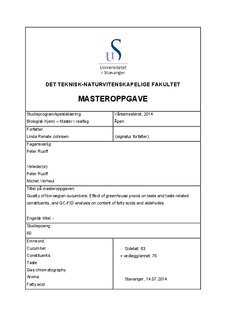| dc.description.abstract | Earlier studies have shown that sugars (SSC), salts (EC) and the relationships
between sugars/salts and sugars/acids (TTA- total titratable acids) may impact taste
in cucumber. In this study, the impacts of environmental conditions in greenhouses
on appearance, taste, and content of taste related constituents in cucumber are
examined.
Cucumber were sampled from eight different greenhouses, and analyzed regarding
appearance of morphological features as well as constituents. The daily light integral,
average temperature, CO2, and vapour pressure deficit were calculated from
measurements and registrations from the greenhouse’s climate control program. EC
and pH levels of the irrigation- and drain water were measured each harvest day.
Statistical analysis showed significant relationships between greenhouse practices
and taste related constituents. Both the daily light integral, CO2 and EC found in drain
and irrigation water had significant effects on the EC measured in fruits, and could
explain between 11 and 33 % of the variation of EC in fruit. Regarding pH in fruit, it
seemed as the pH in both drain and irrigation water had strongest impact, with
explanatory values of around 12 %. SSC show significant negative correlations to
DLI(plant), temperature, and VPD, and may be positively affected by maximum CO2
levels 4 days (and earlier) before harvesting, and pH levels in irrigation and drain
water. But all explanatory values for SSC were relatively low.
Flavour in fruit is a function of both the taste parameters described above, and
aroma. The aroma compounds ((E)-2-nonenal and (E,Z)-2,6-nonadienal) in
cucumber are known to be derivates of fatty acids (linoleic- and linolenic acid). In
order to examine the relationship between these compounds in different varieties of
cucumber, chromatographic methods were improved. (HS-SPME) GC-FID analysis
was used to quantify the levels of aroma compounds, and (FAME) GC-FID analysis
to quantify the level of fatty acids. Significant correlations were found between
content of the two aromas (E,Z)-2,6-nonadienal and (E)-2-nonenal, and between the
two fatty acids linoleic-, and linolenic acid. The results also indicate that the different
varieties of cucumber may vary in content of fatty acids and aroma’s. Further study is
required to confirm if this variance is relevant for taste in cucumber. | nb_NO |

